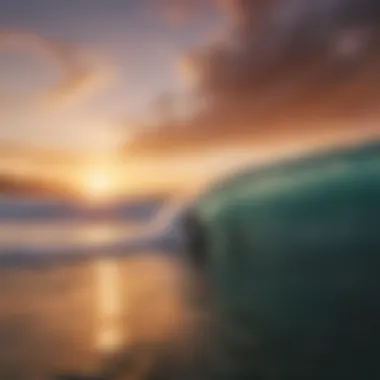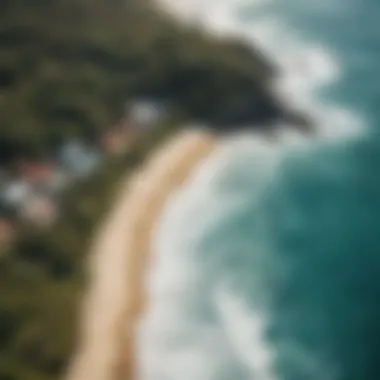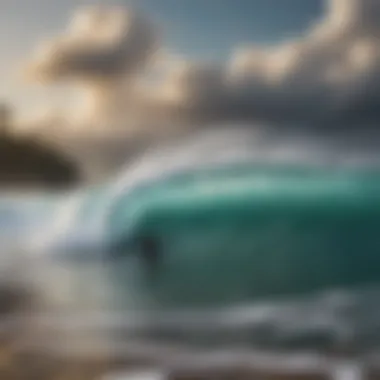Optimal Surfing Seasons in Costa Rica: A Comprehensive Guide


Intro
Surfing in Costa Rica is more than a sport; it's a way of life that merges with the rhythm of nature. The waves here, shaped by the intricate dance of wind and water, offer a playground for both novices and experts alike. But knowing when to hit the beach can make all the difference between a good session and a legendary one.
Understanding the local climate, swell patterns, and seasonal shifts is crucial for anyone wishing to ride the waves in this Central American paradise. From the bustling shores during peak season to the serene, wave-laden coastlines in the quieter months, each period has its unique charm.
This guide aims to shed light on optimal surfing seasons in Costa Rica, revealing the nuances of each month and how different weather conditions can impact your surfing experience. By diving into various surf spots, you’ll discover when to catch the big ones or enjoy a peaceful paddle.
"Costa Rica’s waves are like a canvas waiting for a brushstroke; the right timing can lead to a masterpiece on the water."
The exploration spans from assessing peak months filled with surfers chasing adrenaline to identifying those hidden windows of tranquility when you can practice your skills with fewer distractions. Experienced surfers will find valuable insights, while beginners will get an understanding of how to align their surfing adventure with their skill level and comfort.
Get ready to embark on a journey through Costa Rica’s vibrant surf seasons and uncover how to best enjoy its waves year-round.
Understanding Surf Seasons
Understanding surf seasons is essential for anyone looking to ride the waves in Costa Rica. This beautiful Central American country is celebrated among surfers for its diverse surf spots, which are influenced by various climatic and geographical factors. Knowing when to hit the beaches can make all the difference in finding quality waves and avoiding crowded line-ups. In short, grasping the concept of surf seasons can significantly enhance your overall surfing experience.
When we look at surf seasons, we typically consider two main time frames: the high season and the low season. Each comes with its own set of attributes, including wave quality, water conditions, and the overall ambiance of the surf spot. For instance, high season generally attracts more surfers and visitors, creating a lively scene at popular spots like Tamarindo or Jaco. Conversely, low season often means fewer crowds, allowing surfers to enjoy a more laid-back atmosphere while still catching formidable swells.
Defining High and Low Seasons
High season for surfing in Costa Rica usually kicks off around December and runs through April. During this period, the northern hemisphere enjoys winter, and strong swells roll in from the Pacific Ocean. The beaches become bustling hubs of activity, and experienced surfers can take advantage of consistent waves and favorable winds. The famous Guanacaste and Puntarenas regions see their fair share of action, drawing both locals and tourists alike.
On the flip side, low season spans from May to November. This period is marked by the arrival of the rainy season, resulting in varying surf conditions. While some may shy away from the idea of surfing during this time, it brings unique benefits. Lesser crowds mean that surfers can explore the less commercialized beaches and discover hidden gems away from the hustle and bustle. Moreover, certain spots like Pavones begin to show off their full potential, offering long waiting sets for those willing to brave the elements.
Impact of Weather Patterns on Surfing
Weather patterns play a pivotal role in shaping surf conditions. Costa Rica is well-known for its tropical climate, which means that rain and sunshine can be unpredictable.
The El Niño phenomenon, for instance, can cause changes in ocean temperatures, which in turn affects wave patterns. Surfers often keep a keen eye on such phenomena to anticipate swells, ensuring they make the most of optimal surf days.
In addition, wind patterns are crucial; they can either uplift the surf experience or wreak havoc on wave quality. For example, offshore winds generally create cleaner and more organized surf, while onshore winds can lead to choppy waves.
"The only thing worse than a flat day is a windy one. Make sure to know the wind forecast before heading out!"
Understanding local weather patterns gives surfers an edge in planning their trips, helping to identify the best times to hit the water. Thus, the significance of comprehending surf seasons cannot be overstated; it enhances not just the chance of catching a good wave but also enriches the overall surfing adventure.
Monthly Breakdown of Surf Conditions
Understanding the monthly variations in surf conditions helps surfers craft their ideal trip. Each month in Costa Rica brings its own unique flavor to the ocean, influenced by weather patterns and seasonal changes. Whether you’re riding your first wave or are a seasoned pro, knowing the surf conditions can be invaluable. This section will draw attention to specific months, shedding light on the nuances that define the surfing experience throughout the year. Let’s dive into the details.
January to February: The Calm Before the Waves


As the new year unfolds, January and February are often seen as a transitional period. Surf conditions tend to be more laid back, which can be appealing for newbies. The swells during these months are generally smaller and more manageable. For those just finding their feet on a board, this is golden.
In terms of weather, these months attract plenty of sunshine and dry days, perfect for those who enjoy spending time on the beach when not in the water. Yet, seasoned surfers might find themselves itching for some heftier swells.
"While it may seem tranquil, the coastal scenery is vibrant and alive, inviting everyone from beginners to seasoned surfers to enjoy the beach without the throngs of crowds."
March to May: Transitioning Into the Swells
Coming into March, the tides begin to change. Every passionate surfer knows that as the waves get bigger, the excitement rises too. This period heralds an increase in swell consistency, particularly as the end of April approaches. The wind conditions tend to shift as well, contributing to more favorable surfing situations.
Typical hotspots, such as Tamarindo or Jaco, start buzzing with life, attracting more surfers to the shores. The weather also plays a role, with bright sunny days coexisting with the beginning of the rain season later in May.
This is the perfect time for surfers to step up their game. With adequate wind and swell, surfers will find conditions ripe for improvement.
June to August: Embracing the Rain and Surf
June marks a significant shift as the rainy season kicks into high gear. The tropical showers, while heavy at times, have their own charm. The key takeaway is that the ocean transforms into a paradise for wave riders. Larger swells fill the ocean, particularly in June and July, creating thrilling challenges for seasoned surfers.
However, it’s not purely about the waves; the rain showers tend to keep the crowds away. This means that surfers can often enjoy pristine conditions without fighting for space.
Venturing out between swells is often met with calm periods conducive to catching some great waves, or simply enjoying the serene backdrop of the rainy season.
September to November: The Off-Peak Advantages
As the peak surfing conditions begin to wane, September to November often sees a dip in tourist activity. Many people shy away from the low season, but this can be a big advantage for surfers looking for less hustle and bustle. The waves are still formidable, and the surf conditions remain consistent.
Arguably, September and October are some of the best months for experienced surfers. The swells can be powerful and punchy, thanks to offshore winds. Surfing during this time brings with it the possibility of catching exceptional waves, all while enjoying quieter beaches.
December: The Return of the Swell
By December, surfers will notice the familiar pattern returning. The initial weeks of this month often reintroduce the sizable waves that herald peak surfing season. With a mix of wet and dry weather, conditions vary, but the excitement is palpable.
Droves of surfers return as December also rings in the holiday season. Spotting festive locals and tourists on the beach is common, all while searching for the next big wave. This month can signify an excellent opportunity for those about to embark on their surfing journey once again, as waves become increasingly approachable.
Specific Surf Destinations and Their Best Times
Surfing in Costa Rica isn’t just about the general seasons; it involves honing in on specific spots that have their unique timings and characteristics throughout the year. Each surf destination offers its own blend of waves, intensity, and conditions, making it crucial for surfers to know exactly when to hit the water. These considerations can determine not just the size and quality of the waves but can also influence crowd levels and overall experience. Whether you’re a seasoned pro or a rookie passionate about riding the tides, knowing the optimal times for each location can elevate your surfing adventure.
Tamarindo: A Year-Round Surf Spot
Tamarindo is a name that echoes across the surf community; known for its consistent waves and vibrant atmosphere, it truly lives up to its reputation as a year-round surf destination. From beginners testing their skills on gentle swells to experts looking to catch exciting rides, there is something for everyone. The beach itself is expansive, offering various surf spots along its shoreline. While the dry season from November to April is peak time, with offshore winds and bigger swells, the rainy season can provide quieter sessions with manageable tides.
What's fascinating is that you might stumble upon a local surf competition in full swing when the vibe is just right. It doesn’t hurt that Tamarindo is also home to a bustling nightlife and some riveting restaurants where you can unwind after an exhilarating day on the waves.


Jaco: Peak Season Insights
Just a couple of hours from San José, Jaco has built quite a reputation as a surf hotspot that attracts both locals and tourists. Its proximity to the capital makes it a popular choice, especially during peak season from December to April when the swells are large and the beach is packed. Surfers flock here because of the reliable waves that cater to all skill levels. The west-facing shores also accept swells from both the Pacific’s southern and northern sources, making Jaco an even more versatile location.
If you are looking for that lively surf scene, consider taking a trip during peak season; however, be prepared for crowded waters. For a quieter experience, venturing in the rainy season, which often sees smaller waves but unique rides, can be just as rewarding.
"The beauty of Jaco lies not only in its waves but also in its vibrant community."
Pavones: The Longest Left in the World
Pavones is legendary among surfers; it’s renowned for having the longest left-breaking wave in the world. Located in the southern part of Costa Rica, it draws surf aficionados looking to capture those long, cascading rides. Optimal surf conditions generally occur from April to October, particularly during the South Pacific swell season.
However, even when the primary surf season ends, Pavones frequently gets its fair share of surfable waves, thanks to its geography. The warm waters and picturesque scenery add to the charm, meaning that aside from the surfing, the experience is an all-rounded joy. Just keep an eye out for those busy peak days; sometimes, having a longer ride means sharing it with more surfers.
Santa Teresa: Hidden Gems and Surfing Seasons
Santa Teresa has emerged as a must-visit location for surf enthusiasts, capturing that perfect blend of beautiful beaches and solid waves. Although considered somewhat of a hidden gem, the reality is that its reputation has spread far and wide in recent years. The best time to visit is during the dry season from December to April, when the northern swells roll in consistently.
What many fail to recognize is that the off-peak months, such as September and October, can also deliver fun waves while offering a more laid-back vibe without the crowded beaches. Shops and schools may offer discounts during this quieter period, making it a financially appealing time to enhance your surf skills.
Nosara: Consistent Waves Throughout the Year
For those who seek a reliable spot without too many fluctuations, Nosara is it. Known for its year-round surfable conditions, it attracts a diverse crowd of surfers, from beginners to professionals. The special charm of Nosara lies in its consistent wave action, driven by the tides and ocean currents, making every visit worth your while.
The dry season from November to April is the busiest, but even during the rainy months, surfers often find manageable swells with less competition. Additionally, the commitment to ecological preservation in the area creates a serene atmosphere, allowing surfers to connect with nature while honing their skills.
Local Factors Influencing Surf Conditions
Understanding the local factors that influence surf conditions is essential for surf enthusiasts looking to get the most out of their experience in Costa Rica. It's not just about the seasons or the waves; it involves a complex dance between ocean currents, wind patterns, and the geography of the coastline itself. Delving into these specifics enables surfers—whether they are just starting out or have years of experience—to make more informed choices about when and where to hit the waves.
Familiarizing yourself with the intricacies of these elements can significantly enhance your surfing adventures. By being attuned to local conditions, surfers can not only choose the best time to surf but also anticipate changes that might affect their sessions. Some specific elements to keep in mind include:
- The impact of ocean currents on wave formation.
- The role of wind in both wave shape and overall surfability.
- The geographic nuances of different spots along the coast.
Ocean Currents and Their Effects
Ocean currents are like the veins of the ocean; they transport warm and cold water around the globe. In Costa Rica, these currents can dramatically change your surfing experience. For example, the Costa Rican Pacific Coast is influenced by prominent currents like the North Equatorial Current. This current plays a critical role in generating swells, bringing in powerful waves that can make your surf session exhilarating or, conversely, a bit too intense.
Surfers must recognize how these currents interact with local geography. For instance, places like Pavones thrive on currents that position themselves just right for optimal swells. Conversely, at other locations, currents might bring in excessive debris or chop that can disrupt smooth surfing. Being aware of these effects can directly impact session quality.
Wind Patterns: A Double-Edged Sword
Wind patterns can either be your greatest ally or your worst enemy. On one hand, offshore winds can create pristine conditions that sculpt beautiful waves. These winds push the water away from the shore and allow the waves to rise cleanly. For instance, during the dry season, which typically runs from December to April, the offshore winds are more prevalent, offering favorable conditions for surfers in spots like Tamarindo and Playa Grande.


On the flip side, onshore winds tend to stir things up and can make for choppy, less rideable waves. The rainy season often brings these less favorable wind conditions, especially in the afternoons. If you find yourself on the water when the winds turn, it might be time to call it a day or seek out spots that are more sheltered.
In summary, the interplay of ocean currents and wind patterns is critical in determining the quality of surf conditions in Costa Rica. Combining an understanding of these local factors with seasonal insights showcased in this guide provides a well-rounded approach to surfing in this rich and diverse region. The waves are waiting; the more you know, the better prepared you'll be to tackle them.
Surfing Etiquette and Best Practices
Surfing is more than just riding the waves; it’s a culture grounded in respect and community. Understanding surf etiquette and best practices can elevate your experience significantly, whether you're carving through the swells or chilling on the beach. It helps you stay safe, builds bonds with fellow surfers, and preserves the ocean's environment.
Respecting the Local Surf Culture
Every surf spot has its own vibe, shaped by the local surfers who ride those waves daily. When you step into these waters, it's crucial to pay homage to their culture. A simple smile or greeting can go a long way in establishing a connection. Moreover, sizes of waves and power often define the local expertise, and traffic can sometimes create a tense atmosphere. In many communities, experienced surfers have rooted traditions that new arrivals should navigate thoughtfully.
- Observe Before You Act: Watch how locals interact; this can provide insight into unspoken rules.
- Be a Part of the Community: Acknowledge their presence and ask for tips during your stay. This not only helps you improve your skills but also fosters camaraderie.
- Leave No Trace: Respect the land and the ocean. If you bring snacks or drinks, make sure you leave with everything that you came with. The ocean is beautiful; let's keep it that way!
In some places, especially popular surf spots in Costa Rica, locals may be protective of their waters. Being amiable and showing respect can soften any initial hesitation they might have about sharing their waves. As a guest in their territory, honor their customs and traditions for a fulfilling surfing experience.
Understanding Wave Priority
Wave priority might seem like a minor detail, but in reality, it’s the backbone of surf etiquette. Understanding who gets to ride what wave can prevent accidents and ensure everyone has a great time. In simple terms, the surfer closest to the peak of the breaking wave has the right of way.
However, there are nuances to this concept. For example:
- Positioning: If you're paddling for a wave, look over your shoulder. If someone is closer to the peak, let it go. This not only keeps you safe but also encourages good vibes in the water.
- Communication: If you're unsure, it doesn’t hurt to signal with a wave or a nod. Most surfers appreciate clarity and may respect your effort fully.
- Be Mindful in Crowded Waters: In busy surf spots, it’s vital to keep aware of your surroundings. A reckless duck dive or a late entry can lead to collisions and injured surfers.
- Respect the Small Stuff: Sometimes, beginners may need a wave just as much as experienced surfers. Patience goes a long way, especially in popular areas.
"A surfer should never be the one who spoils a fun moment. Respecting the rules of the water and prioritizing safety contributes to a positive surf culture."
By observing the rules of wave priority, you not only show respect to your fellow surfers but also elevate the entire surf experience. Following these basic guidelines fosters a welcoming environment that enhances everyone’s time in the water.
Culmination: Making Informed Choices for Surfing
Understanding the optimal surfing seasons in Costa Rica equips surfers with the necessary tools to navigate the waves according to their personal preferences and skill levels. With diverse climatic conditions and surf spots sprawled over the coastline, making informed choices becomes essential to enhancing one’s surfing experience. It’s not merely about timing but involves comprehending how various elements interlink to create ideal surfing conditions.
Summarizing Key Insights
Throughout this guide, key insights regarding Costa Rica's surf seasons highlight that one size does not fit all when it comes to surfing. For instance, while high season may promise consistent waves, it also brings crowded beaches that can detract from the experience. On the flip side, exploring the off-peak months might reward surfers with less traffic and the chance to find hidden treasures in smaller, more secretive breaks. Key points to keep in mind include:
- Peak vs Off-Peak: High season runs from December to April. This period showcases the best waves, but often draws in throngs of surfers. Conversely, the shoulder seasons such as May and November provide balance, offering a mix of good waves and fewer surfers.
- Local Insights: Each surf destination has its nuances. Locations like Tamarindo and Pavones have distinct surf patterns, making it critical to pay attention to local lore and tips to maximize one’s session.
- Weather Patterns: Understanding how weather impacts surf conditions can make the difference between an exhilarating ride or a washout. Observing clouds and storms in the distance can provide clues to incoming swells or changing conditions.
Preparing for Your Next Surf Trip
Preparation for a Costa Rican surf trip requires attention to detail. It’s advisable to consider not only your surfing skills but also local conditions and amenities available. Start with the best time for your skill level. Beginners might benefit from the gentler waves found during the rainy season, while experienced surfers could seek the adrenaline rush from bigger swells in the dry season.
Here’s a quick checklist to keep in mind:
- Research Your Locations: Know the spots that appeal to you for both visual beauty and surf quality. Each beach has its own personality and wave structure that might suit your style.
- Local Rentals & Guiding Services: Look for surfboard rentals and local guides who can help you find the best waves. Engaging with guides also opens up opportunities to tips about hidden spots.
- Health and Safety: Familiarizing yourself with basic health precautions, like having sufficient sun protection and hydration, is vital for long surf sessions. Also, research the nearest medical facilities should an emergency arise.
Taking all this into consideration enhances not just the enjoyment of surfing but also ensures that the time spent in the water is the best it could possibly be.
In Costa Rica, knowledge is as essential as the surfboard you ride on.
By embracing a thoughtful approach to timing, location, and preparation, surfers can truly harness the essence of Costa Rica’s vibrant surf culture, making each ride memorable.



